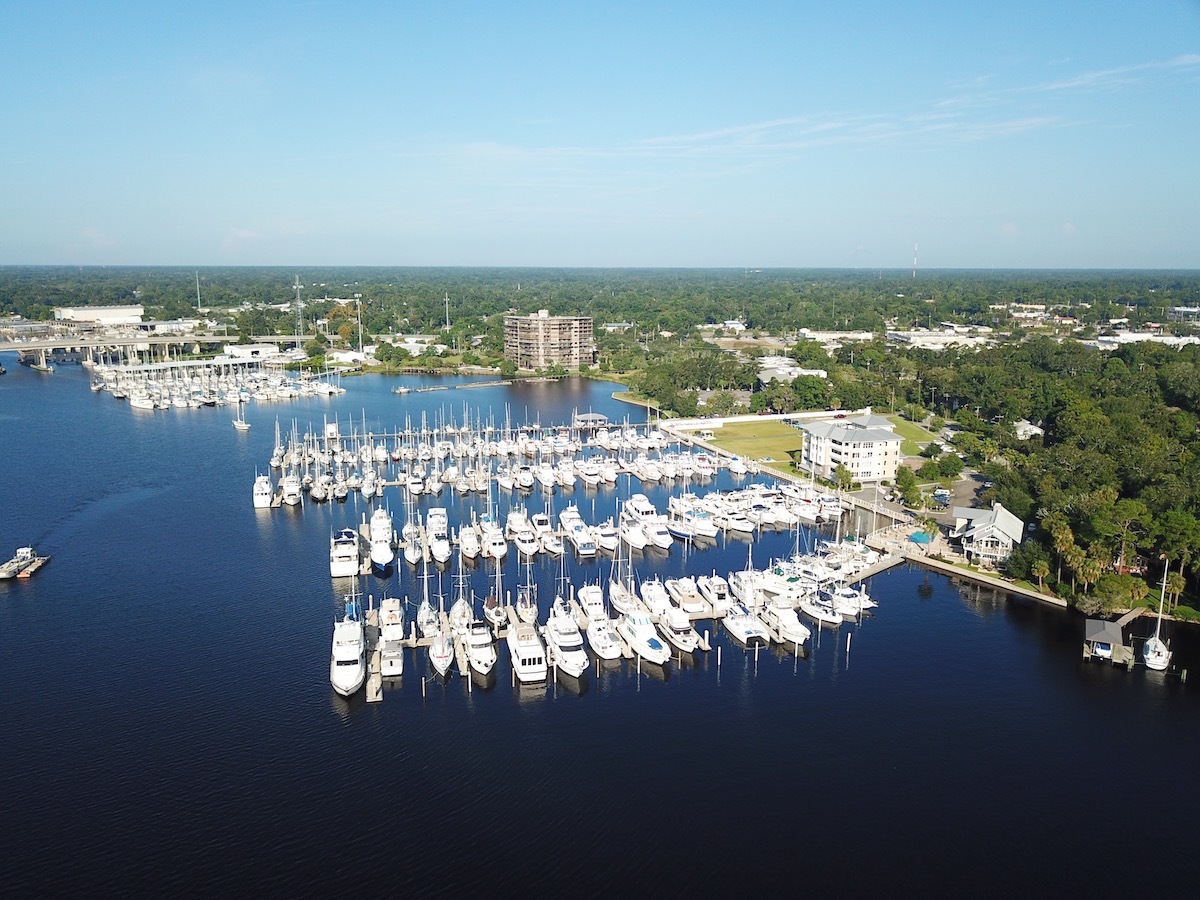
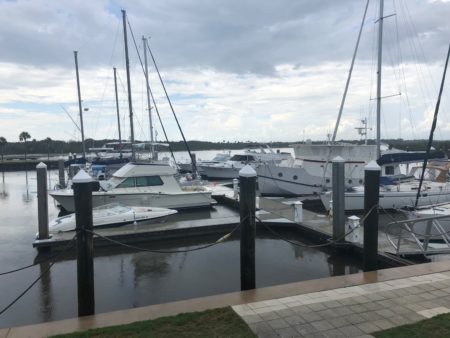
When you share your life online, one of the most common questions you’ll get is ‘How Much Does It Cost?’.
One of the top questions we got when ramping up to cruise after over a decade of RVing was – how would the costs differ?
Now that we’ve got nearly 2 years under our hull (what?!!? where has the time gone), we’re ready to start addressing some of the costs with actual data points.
So today, let’s tackle the costs of keeping your boat somewhere.
Sometimes called marina costs, slip fees, dockage, wet storage, mooring or anchoring.
Prefer the video version? We hosted a live cast presentation on December 13, 2018 overviewing this topic and taking viewer questions. You can view it here… or read on below depending your preference for written or video content.
Biggest Differences between RV Parking & Marina Pricing
As far as costs go, there are some major differences that can impact your costs to stay at marinas:
By the Foot – LOA vs LOH vs LWL:
Campgrounds & RV Parks tend to be a flat rate per site. There may be different categories of sites within any given park with different pricing – full hook-ups, water/electric, dry camping, premium sites or large vs small. But it’s a pretty flat rate that isn’t overly dependent on the size of your RV.
In boating – size is EVERYTHING.
Most marinas charge by the foot. There are some exceptions, like public docks and mooring balls, where pricing could be a flat rate.
And to complicate things even further, every marina may measure your boat differently.
Why? Because boats can have multiple measurements depending on where you measure from.
Here’s a quick graphic we made of our boat to illustrate how Y-Not measures up:
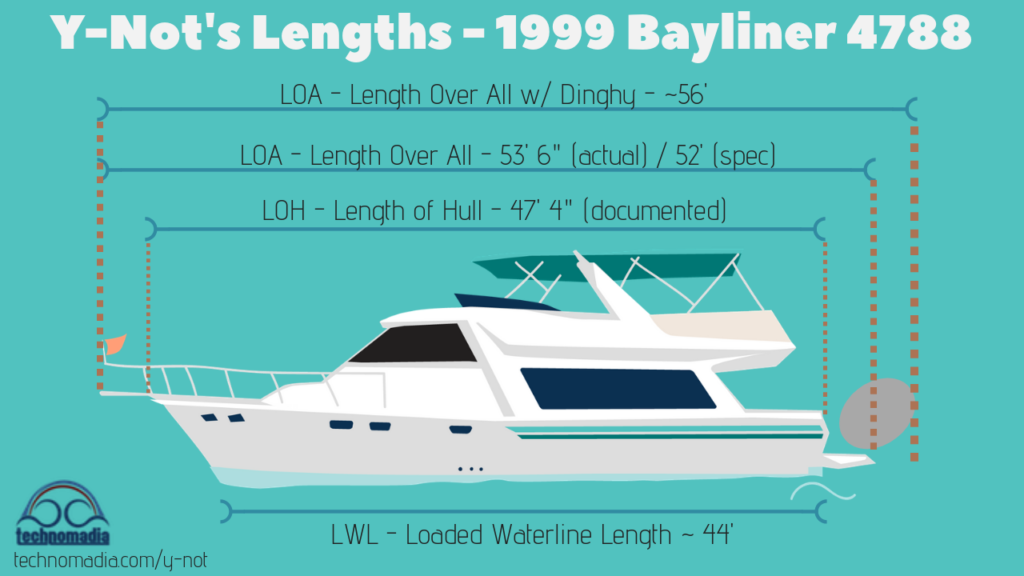
There’s no standard in how a boat manufacturer (and thus brokers) determines the official size of a boat that it gets marketed under. It’s usually somewhere between the loaded length at waterline (LWL), length of the hull (LOH) / length on deck (LOD) or length over all (LOA).
The LOH / LOD doesn’t include extended non-living spaces like the bow pulpit, swim platform or dinghy overhangs.
Whatever length the manufacturer documents their boat as, tends to be what ends up on your official registration, titles and federal documentation. In the case of the Bayliner 4788, it’s officialy 47′ 4″ which seems to be the agreed upon LOH.
But your documented length may not necessarily be how much space your boat takes up.
There’s a joke in boating communities that when asked how long your boat is, your answer might differ depending if you’re answering a dockmaster or boatyard who is charging you by the foot – or if you’re trying to get bragging rights at happy hour.
Most marinas need your overall length (LOA – Length Over All, we’ve also heard Length Over Air) so they can place you in an appropriate slip. But there’s a lot of variance over just what LOA includes. Sometimes it means from the tip of the bow spirit to swim platform and sometimes it includes any dinghy davit system overhang.
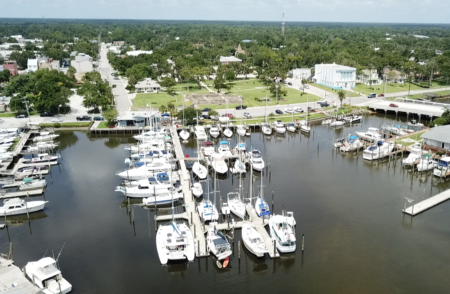
We always tell the dockmaster that our documented hull length is 47′ – but our overall is around 56′ including the dinghy.
We can drop our dinghy to get our length down to 53.5′, which is how the Bayliner 4788 actually came setup. Most have a crane on the flybridge to store the dinghy.
We’ve found that so far, most of the time – marinas charge us for our documented 47′ length. And sometimes they just cut us off there, not even wanting our overall length – they just know to add a few feet when placing boats.
Some marinas are sticklers, and charge you for every bit of length you take up. Some even measure.
And some marinas charge not by your vessel’s size, but by the size slip they place you in.
A lot of boaters only give their documented length hoping to save some bucks, and then when they arrive – their slip is too small for them. This can be unsafe for all involved and even end up with you being turned away.
Note: Width can matter too. Some marinas charge higher rates for vessels that are wider. This includes multi-hull boats that might require a side tie, a wider slip or taking up two slips. For boats our size, a typical width for a slip is 16-20′ (we’re 15′ wide, so we don’t have to worry about this.)
By the Night versus By the Month
On a nightly basis, RV campgrounds are far more affordable than most marina stays we’ve had. We’ve found marina costs to be 2-5 times the cost of typical RV site we tend towards. Except for Causeway Cove Marina & RV Park, where RV spots can actually be more expensive than the slips!
But on a monthly basis, they’re fairly on par compared to local RV park options. Especially for waterfront views and great locations.
Electricity:
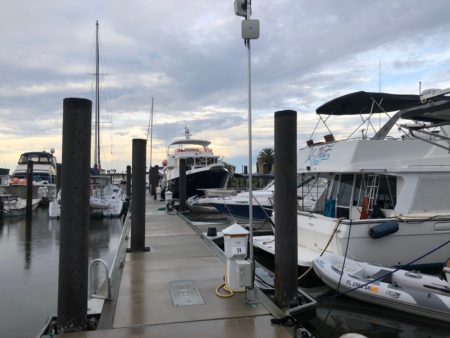
In RV parks, it’s fairly standard that electricity is included in daily and weekly rates. There are rare exceptions of course. On monthly stays, we’ve had both electric included or metered.
In marinas, if you’re staying on a dock with electric, it’s almost always an extra charge.
On daily and weekly stays, it’s typically a flat rate based on 30, 50 or 100 Amp needs (we’re 50A). It ranges from $5-10 per day, or $50-100 per week.
On monthly transient stays, there’s usually a flat charge of $80-150 per month or it’s metered. We’ve been on a meter a few times now, and our typical summer running-all-3-ACs all day long rates have been around $60-100/month.
Thus we prefer metered electric, as it usually works out better for us (and once we have solar, even better!).
Transient Marina Stays
Keep in mind, marinas serve the roll of both an ‘RV park on the water’ and a boat storage lot.
Many marinas thus have different rates for those staying aboard while cruising through, those living aboard long term (ie. not leaving) and those just storing.
As cruisers who are on the move (albeit, slowly) – we generally are dealing with transient rates. Which are offered on daily, weekly and monthly basis.
The range of rates can vary, and here are the typical ranges we’ve seen at least in our cruising ground of Florida since we started:
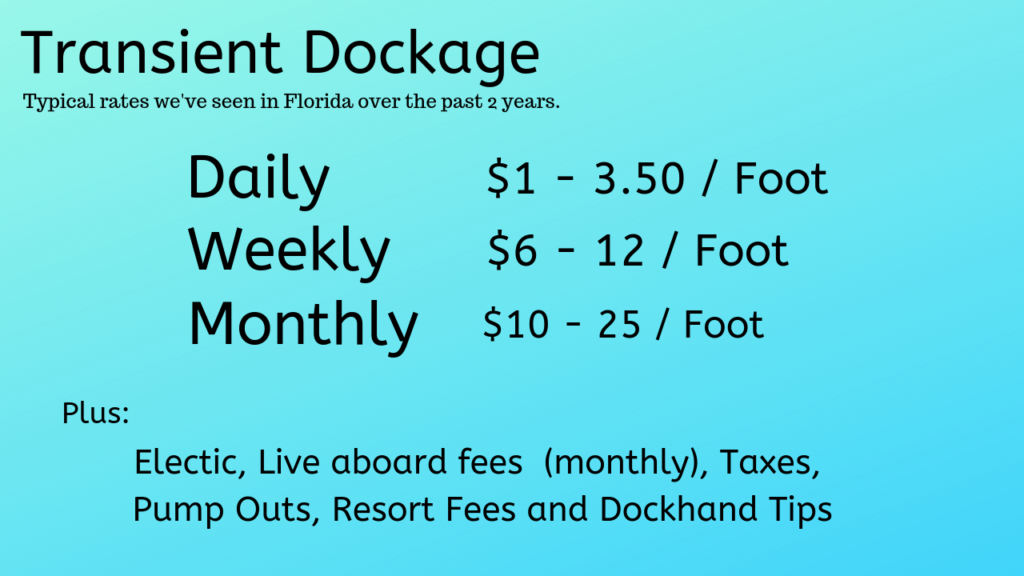
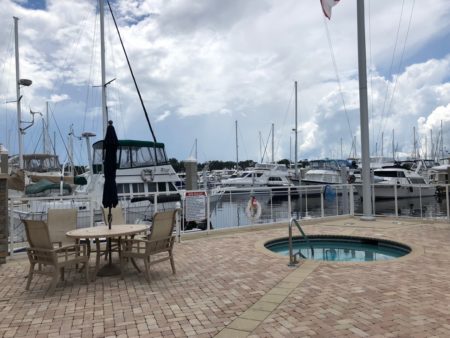
The range is vast, and vary by location, private vs public and amenities offered. There are of course outliers – in prime locations in prime seasons (ie. winter in the Keys!), rate may be even higher.
Here’s everything that may go into what your actual cost will end up being for a stay:
- Base Dockage. Multiply the per foot charge by the # of feet your marina is charging you for (keep in mind, that measurement may vary!).
- Electric. Either a flat fee or metered.
- Live Aboard / Extended Occupancy. These are fees that the marina charges for use of the amenities, and most consider you a liveaboard if you’re on the vessel more than 10 nights in any month.
- Thus far, daily and weekly rates we’ve encountered already assume you’re staying aboard and are priced as such.
- Monthly fees we’ve found to vary quiet a bit. Some marinas offer a separate per foot rate for storage versus staying aboard and some charge a flat $100-150/mo fee (usually per household – sometimes per person or couple).
-
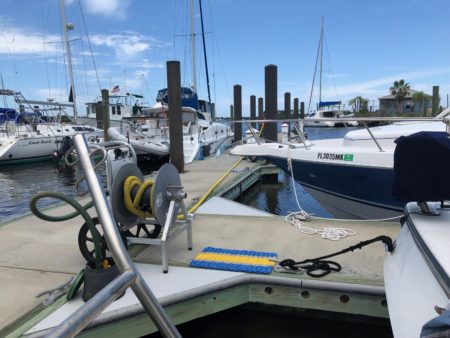
Pumping your waste is sometimes included, sometimes not. Taxes. In the state of Florida every marina, hotel, short term apartment and RV park has to charge sales tax on stays less than 7 months. It’s part of the tourist income. We’ve also been surprised by special purpose extra taxes.
- Pump out fees. Usually dockage includes pump outs on daily and weekly stays. On monthly stays with a live aboard fee charged, we’ve seen them vary so much – sometimes they’re included, and sometimes they’re extra. If the marina took public funding to build their pump out station, then pump out fees are capped at $5. If they’re past their commitment or self-funded then they can charge what they want.
- Tips. Most marinas we’ve been to have a dockhand meet you at arrival to help catch your lines and get your vessel plugged in. It seems general practice to tip $5-10 for this service.
- Extra Fees. There may also be extra resort or daily yacht club membership fees to stay at some facilities, if you’re not already a member.
Here’s some sample dockage rates we’ve paid for daily, weekly and monthly stays to show the range of differences out there:
Of course, not everyone wants to stay precisely one week or one month – and boats don’t always have the option to leave on the scheduled day due to weather. Some marinas are very flexible and will just charge you a pro-rated daily rate based on the weekly/monthly rate you’ve already unlocked. Others will go back to the higher rate if you extend your stay.
We’ve also very often arrived with a shorter reservation and decide to stay a month – and most marinas have been happy to apply our already paid dockage towards the monthly rate.
Long Term Leases
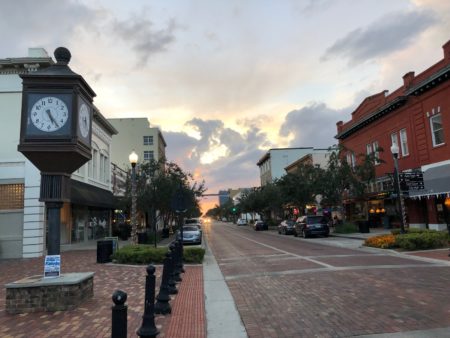
Marinas that offer long term storage or are ‘liveaboard friendly’ might have discounted rates for those staying more than a month. Sometimes the savings is just a small percentage, and sometimes the difference is extreme.
At our current marina, the monthly transient rate is $15/ft. But only $8.80 for longer stays.
This usually involves signing a lease and presenting all of your paperwork (insurance, documentation, registration). You may even have to pass a credit check.
You may also be required to put up a deposit to secure the slip and/or for electric – just like you might when renting a house or apartment.
We’ve typically found that those staying onboard their vessels are also charged a live aboard fee, and then electric is charged separately.
If you’re leaving your boat behind, some marinas may offer absentee care packages to have a staff member watch over your boat and prepare it for your return.
Otherwise, long term lease charges are similar to monthly transients.
Our 2018 Marina Costs
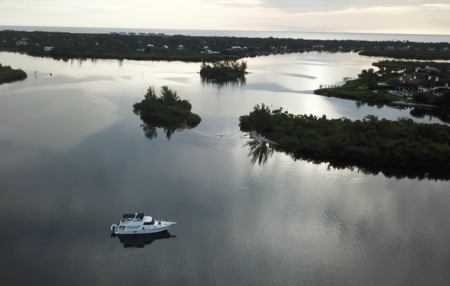
When we started our cruising lifestyle, we had the vision that we’d be mostly anchored out as we made miles and then perhaps staying a few days a month in marinas for shore access, provisions, pump outs and such.
If we were following a typical Great Loop pace, that probably would have worked out.
But we’ve found that we really are enjoying the slower pace of life that more frequent monthly stays is giving us.
Anchoring out is awesome, and we do love it – but getting ashore can be an obstacle.
And so many marinas are located right in the heart of city centers – giving us stellar access to stuff right out our front (or back) door.
Plus, it turns out, the costs aren’t all that much higher than paying for a few days of dockage a month.
Our costs in 2018 reflect this – a lot of monthly stays, 31 days in total of anchoring out in between locations, some mooring ball time and a few scattered daily/weekly stops.
Here’s how it balanced out this year:
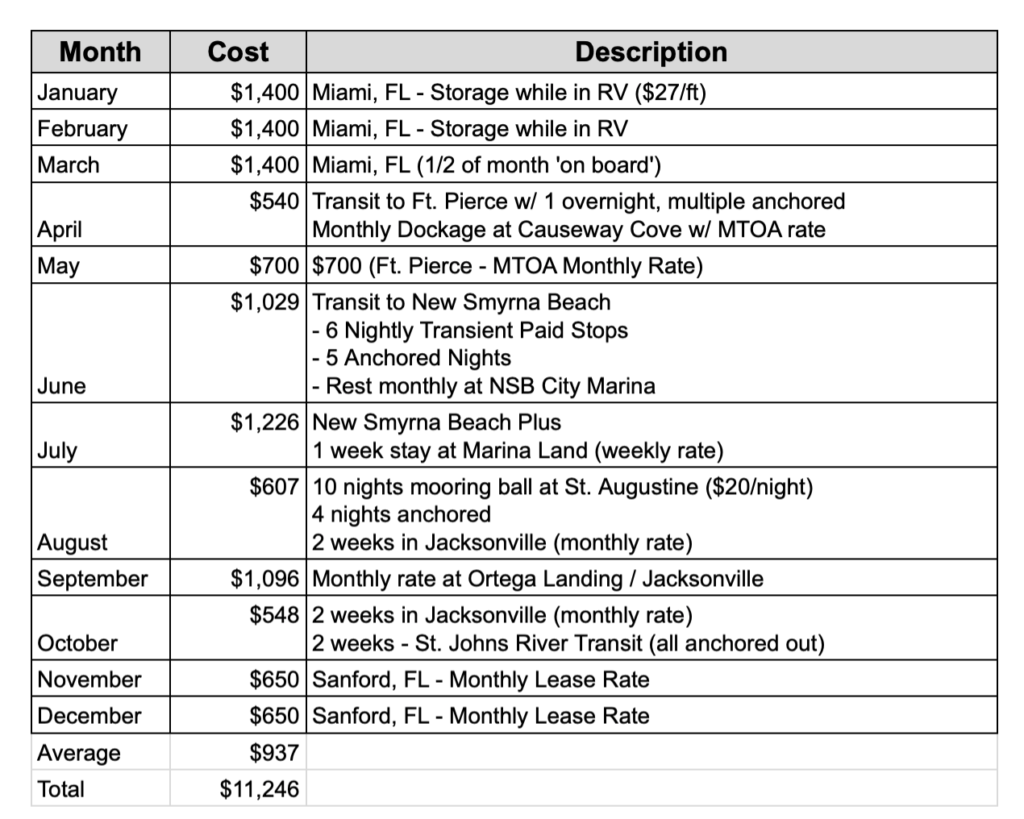
Had we not ended up stuck in south Florida after our boat repairs for three months when we needed to store the boat for our return to our RV – our average would have been much lower.
And because of a slower pace of travel, our fuel costs were pretty low – just $1338 for 2018.
For comparison, in 2016 (our last year in which we were exclusively RVing) our average campground fees were $510/month. Our style of RVing then was a mix of free boondocking and 1-2 week stays in public campgrounds. Had we been staying places monthly in cool high demand cities like we are when boating – the costs would have reflected that.
I anticipate our style of travel will always shift. And we would love to integrate in more anchoring out time now that we’re getting more and more electrically independent.
All and all, we’re pretty darn happy with how affordable our style of marina life has been.
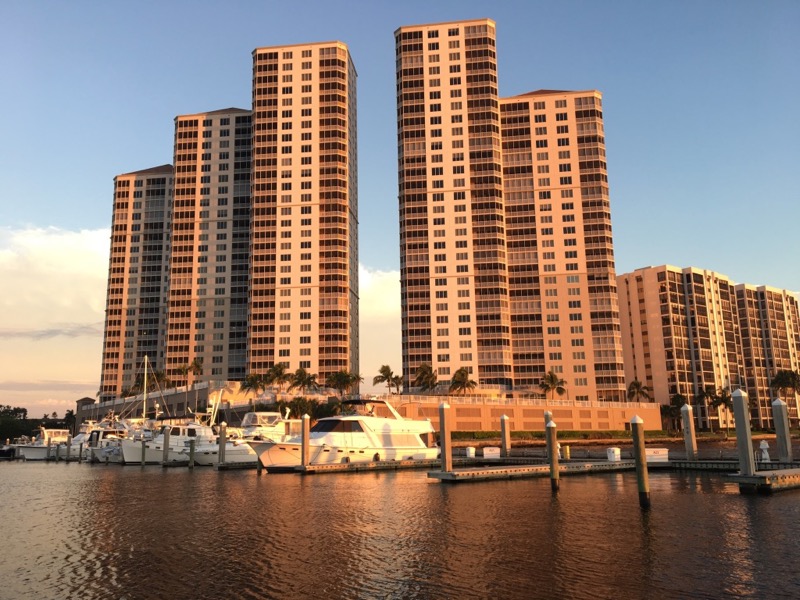
Especially when we’re staying places where a view of our marina often commands nearly million dollar condo prices.
Related Posts:
Boat vs RV & First Impressions of Living Aboard a Boat
Pouring Rent Into the Tank: A Perspective on Fuel Costs for Full Time RVers and Boaters

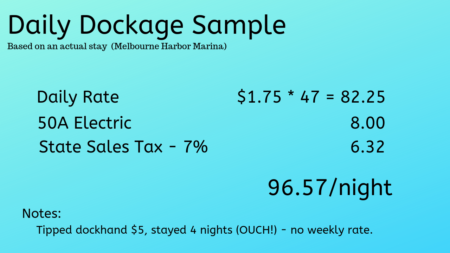
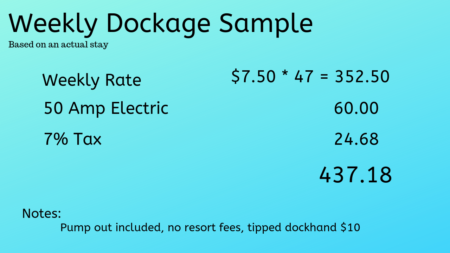
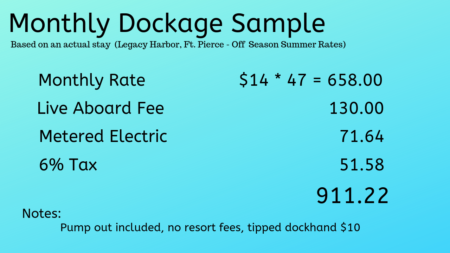
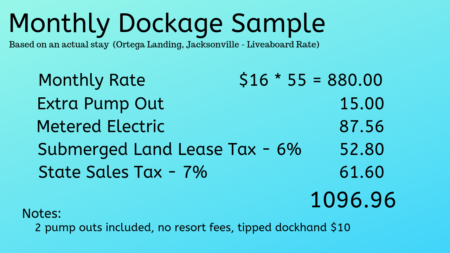
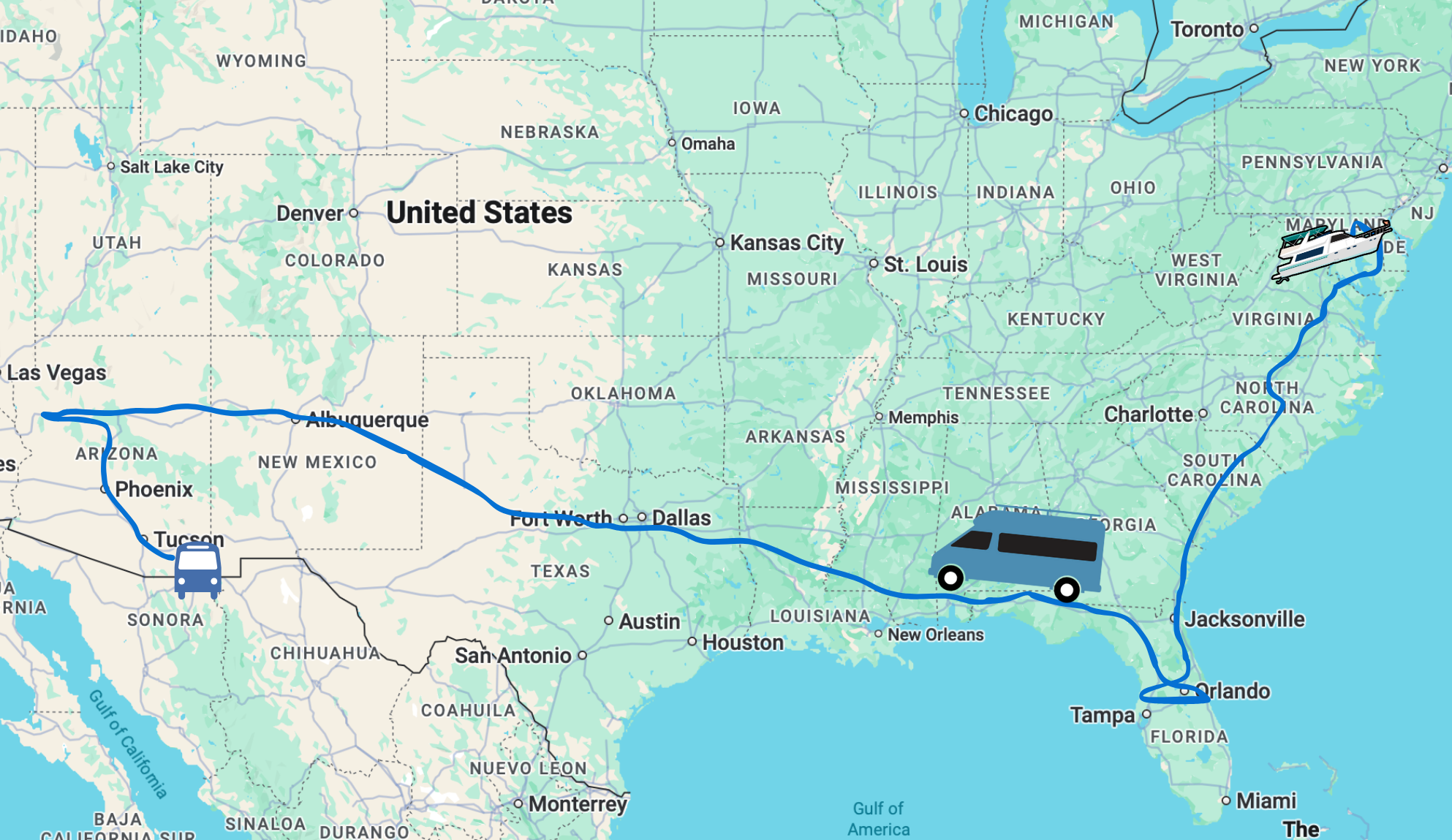
Thanks for the good information. We are currently ”stuck” in the PNW due to family obligations. We’ve been headed toward a boat and being here has peaked our interest in boating the PNW again (grew up on a boat here).
It is interesting to understand all the nuances of pricing and good to compare areas as we do our research.
Marina life is really cool. So enjoy following your adventures.
Very, very helpful, Cherie and Chris. I’ve long admired your strategy of using the lower monthly rates to accomplish this trip. We’re several years away from starting our loop and on the wrong (west) coast. I’ve often tried to figure out how I might work one spring/summer from our east coast office while living on the boat and taking advantage of staying in two or three different marinas over the course of the season. Need to get a boat first!
Great info. Remind me to never ever buy a boat 😉 One winter I paid $9 for the winter, and that was 3 nights at $3. at Hot Well Dunes. Last winter I splurged for a $15. annual permit to stay on Arizona State Trust Lands! Says the guy who just laid out $3000. in vet bills for my cat this week, and she’s not better yet …
Now, anchoring out I might just enjoy! Perhaps we’ll see you with the bus next winter! Enjoy!
With a focus on anchoring out, it’s very possible to bring the costs way down. But sometimes, anchoring out just isn’t a viable option.
Wow! I’m surprised that the cost is that low. I thought it would be much more expensive than RV parks. Thanks for sharing. We just retired and started full-time RVing and we’re in our 60’s so little to no chance we’ll be doing what you two are doing. We sure enjoy following you however. We’re at Kure Beach, NC right now and think of you every time we cross the Intercoastal. You have SO much fun ahead of you! It is beautiful up here. You could take 10 years to complete the loop! So many great places. Heck we’ve been here a month and can’t believe it’s time to move on already. Enjoy Florida!
For sure, the longer we cruise the more we lean towards it taking us a decade to complete the loop. And that’s alright by us!